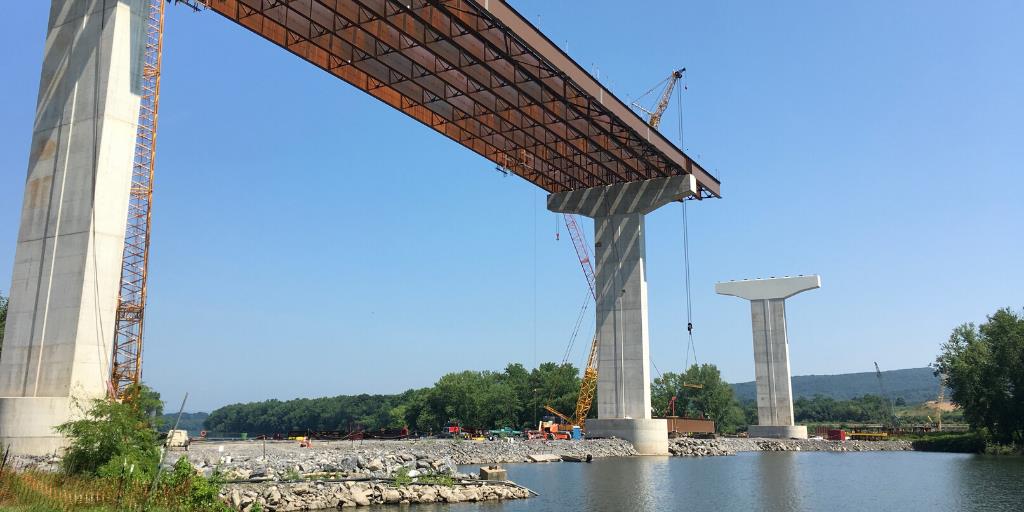
With thousands of waterways draining into five different major river basins, Pennsylvania's topography poses a challenge for PennDOT, especially as it applies to the construction of bridges.
With its eye on using innovative approaches to more efficiently carry out its mission, PennDOT has embraced next generation hydraulic tools to design the largest bridge project now underway in Pennsylvania.
PennDOT and its contractors used a cutting edge two-dimensional (2D) hydraulic modeling analysis tool to design the 15-span, 14-pier bridge carrying the new Central Susquehanna Valley Transportation Project (CSVT) expressway over the West Branch Susquehanna River between Lewisburg and Sunbury.
The project relied on TUFLOW, a relatively new 2D computer program that simulates depth-averaged, 1D and 2D free surface water flows. TUFLOW was used to better model the flow of water around the piers of the structure, which was critical in assessing flooding impacts to surrounding areas.
"Conventional one-dimensional (1D) hydraulic analysis for the CSVT river bridge originally indicated the new structure would cause minor increases in flood elevations that would extend several miles upstream," said Matthew Beck, P.E., an assistant plans engineer for PennDOT District 3. "Although numerous bridge piers are required across the West Branch Susquehanna River's fairly wide floodplain, results did not seem realistic. We looked to more advanced analysis tools that could more accurately model the backwater effects of piers in areas of subcritical flow."
The hydraulic modeling results demonstrated that the project would cause localized increases in the 100-year flood elevation in the floodway of the West Branch Susquehanna River. It also showed that those increases would be localized around the piers, extending only a few hundred feet upstream, rather than several miles as originally indicated by conventional 1D modeling.
The Federal Highway Administration (FHWA) is encouraging states to shift from 1D to 2D modeling through the "CHANGE: Collaborative Hydraulics: Advancing to the Next Generation of Engineering," an Every Day Counts (EDC) innovation, championed by the Pennsylvania State Transportation Innovation Council.
The 2D modeling results "can significantly improve the ability of highway agencies to design safer, more cost-effective and resilient structures on waterways," according to FHWA. Among the benefits FHWA cites are more accurate representation of flow conditions, streamlined project development and better tools for communicating often complex interaction between waterways, the transportation infrastructure and the surrounding environment.
"Other agencies support the use of next generation hydraulic tools as well," Beck said. "The 2D analysis allowed us to obtain Federal Emergency Management Agency and Pennsylvania Department of Environmental Protection approvals based on realistic modeling and ultimately allowed this major transportation improvement project to move forward in a timely manner."
ABOUT THIS BLOG
Did you know PennDOT is directly responsible for nearly 40,000 miles of highway and roughly 25,000 bridges? We oversee programs and policies affecting highways, urban and rural public transportation, airports, railroads, ports and waterways, in addition to administering the state's more than 11 million vehicle registrations and 8.8 million driver's licenses.
So, how do we do what we do? And how can we help you travel in Pennsylvania — whether it be for business or leisure — in safe and enjoyable manner? Read PennDOT Way to learn more about the department, what we do, and how and why we do it.
TAGS
50-Year Anniversary, 511PA, Aggressive Driving, Airports, Autonomous Vehicles, Bicycles, Bridges, Child Safety, Community Relations, Construction, COVID-19, Distracted Driving, District 1, District 10, District 11, District 12, District 2, District 3, District 4, District 5, District 6, District 8, District 9, DOTcom, Driver and Vehicle Services, Emergency Responders, Employment, Equity, FAQ Friday, Human Trafficking, Impaired Driving, Innovations, Live Free Ride Alive, Maintenance Monday, Motorcycles, Older Drivers, PA Motorcycle Safety Program, Pedestrians, PennDOT Connects, Ports, Public Transit, Railroads, REAL ID, Road MaP, Roadside Beautification, Rural Roads, Safety, School Buses, Seat Belts, State Transportation Innovation Council (STIC), Sustainability, Teen Drivers, Throwback Thursday, Transportation Funding, Travel in PA, Welcome Centers, Winter, Work Smart, Work Zone, Yellow Dot
LATEST POSTS
PennDOT Continues Sharing, Updating Resources for Local Governments to Pursue Bipartisan Infrastructure Law Funding Opportunities
Norwin High School Wins 2024 ‘Innovations Challenge’
Demo Complete: I-95 CAP Project in Center City Philadelphia
PennDOT Archeologist Connects Past, Present, and Future
Lehigh Valley DUI, Highway Safety Task Force Hosts Law Enforcement Seminar
ARCHIVES
2024
2023
2022
2021
2020
2019
2018
2017

